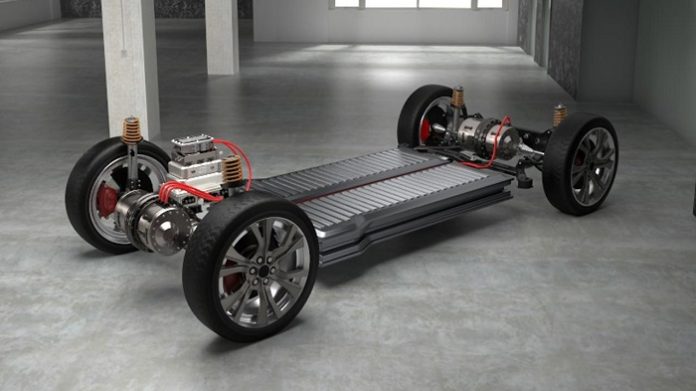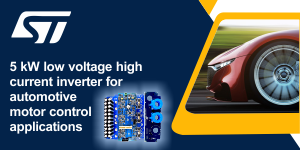Today’s electric vehicles cost, on average, $12,000 more to produce than a conventional car with a combustion engine.1 As carmakers focus on meeting worldwide emissions regulations, they must also close the affordability gap to help consumers make the switch to hybrid or full-electric vehicles.
This is a big challenge for automotive design engineers grappling with how to improve efficiency and reliability and extend driving range while also reducing the cost of the most expensive part of the EV — the powertrain system. EV powertrain integration may be one of the keys.
Hybrid and EV powertrains have traditionally been an amalgam of the systems that propel cars forward, with the battery, DC/DC converters, onboard charger and traction inverter housed in separate enclosures. Advances in analog and embedded processing technologies now enable designers to combine these systems using a single domain controller and power stage – which helps designers increase efficiency and reliability, while reducing costs – and comply with functional safety standards.
“It’s about getting the best out of the system by meeting the essential technical and safety requirements while making it more affordable for mass use,” said Karl-Heinz Steinmetz, who leads our company’s worldwide automotive powertrain system engineering team.
VMAX, an EV component supplier headquartered in Shenzhen, China, is learning firsthand the advantages of powertrain integration.
“Powertrain integration is a key to designing EVs that are more efficient, reliable and affordable for consumers across China,” said Han Yongjie, vice president of VMAX. “Texas Instruments’ technologies and expertise are helping us achieve the level of integration our customers require for on-board chargers, DC/DC converters and traction inverter systems.”
Achieving more driving time with greater efficiency and higher power density
Bringing powertrain systems into a single, compact mechanical enclosure does not just make design and assembly simpler. Integration also reduces the need for surplus packaging materials and eliminates redundant hardware, significantly decreasing the system’s weight and volume.
“Every kilogram is a major part of the efficiency equation,” Karl-Heinz said. “If you can reduce the weight of the car, you can improve the overall efficiency and how far you can drive on a single charge.”
Innovations that raise efficiency through increased power density are also key. EVs that incorporate technologies such as automotive-qualified gallium nitride (GaN) technology can help extend driving range by operating at a higher efficiency and retaining thermal energy. That means fewer cooling components and lower costs.
“Wide-bandgap switches, made of materials such as GaN, working with optimized high-speed gate drivers, will be a game-changer – as they can enable 60% smaller magnetic components, reducing overall weight and cost,” said Ramanan Natarajan, a marketing team member for GaN at our company.
Turning integrated powertrain architectures into reality also requires real-time microcontrollers (MCUs) that can handle the sophisticated demands of power conversion. The ultra-low latency of our C2000 MCUs helps enable a higher switching frequency up to 1 to 2 MHz, which means smaller external components such as inductors and capacitors.
“With real-time sensing and a higher switching frequency for the control loops, we can drive the traction motor to 20K RPM,” said Na Kong, automotive manager for C2000 MCUs at our company. “This allows automotive engineers to build motors that are more than one-third smaller and higher performance than previous designs that reached only 10K RPM.”
With an integrated powertrain architecture that includes a single real-time MCU, the system can efficiently handle the jobs of multiple MCUs in distributed systems. In a highly integrated design, a real-time MCU can perform both digital power and motor control to enhance efficiency while conserving valuable space.
“When carmakers shift to an integrated architecture, the decision is about consolidating resources and chips in the system,” said Karl-Heinz.
Boosting reliability and meeting functional safety standards
In an EV, like traditional automobiles, system reliability is crucial. An integrated powertrain architecture is more reliable because there are fewer parts that can break. Outside of the inherent advantages of an integrated system, ensuring reliability in the high-voltage battery environment of an EV also requires robust protection and peak thermal performance.
Isolation technology is helping address these challenges with isolated gate drivers and modulators designed and tested for harsh automotive environments. Integrated diagnostics are also a vital part of the safety equation and can help powertrain systems comply with ASIL D, the highest level of functional safety for road vehicles and a key challenge for EV manufacturers.
“We understand that functional safety capability is crucial to the overall design, and we take those considerations very seriously. We underline our focus on safety through our reference design, which has been independently assessed by TÜV SÜD and can help our customers customize their system design with superior cost control,” Karl-Heinz said.
Supporting the accelerating growth of the EV market through powertrain integration
The EV market is experiencing rapid growth. Today’s 5.6 million vehicles are expected to increase to 30% of all automobile sales globally by 2025.2 Powertrain integration will play a key role in that acceleration. Integrated powertrain systems have already demonstrated 40% to 50% increases in power density and substantial reductions in volume, weight and reliability.
“This will have a significant impact on the capability of EVs and the driving range per charge, ultimately making these cars more affordable,” Karl-Heinz said.
Living our passion to create a better world
Helping our customers’ design integrated powertrain systems is one example of how TI innovators are living our company’s passion to create a better world by making electronics more affordable through semiconductors. As each generation of innovation builds upon the last to make technology smaller, more efficient, more reliable, and more affordable, new markets open and it becomes possible for semiconductors to go into electronics everywhere. At TI, we think of this as Engineering Progress. It’s what we do and has been doing for decades.
Authored By: Karl-Heinz Steinmetz, General Manager, worldwide automotive powertrain system, Texas Instruments









